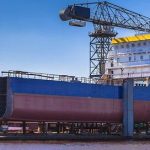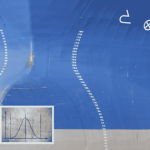The design of ships employs many technologies and branches of engineering that also are found ashore, but the imperativesof effective and safe operation at sea require oversight from a unique discipline. That discipline is properly called marine engineering, but the term naval architecture is familiarly used in the same sense. In this section the latter term is used to denote the hydrostatic and aesthetic aspects of marine engineering.
The measurements of ships are given in terms of length, breadth, and depth. The length between perpendiculars is the distance on the summer (maximum) load waterline, from the forward side of the stem at the extreme forward part of the vessel to the after side of the rudder post at the extreme rear, or to the centre of the rudder stock, if there is no rudder post. The beam is the greatest breadth of the ship. The depth is measured at the middle of the length, from the top of the keelto the top of the deck beam at the side of the uppermost continuous deck. Draft is measured from the keel to the waterline, while freeboard is measured from the waterline to the deck edge. These terms, together with several others of importance in ship design, are given in the figure.

Hydrostatics
The basis of naval architecture is found in Archimedes’ principle, which states that the weight of a statically floating body must equal the weight of the volume of water that it displaces. This law of buoyancy determines not only the draft at which a vessel will float but also the angles that it will assume when in equilibrium with the water.
A ship may be designed to carry a specified weight of cargo, plus such necessary supplies as fuel, lubricating oil, crew, and the crew’s life support). These combine to form a total known as deadweight. To deadweight must be added the weight of the ship’s structure, propulsion machinery, hull engineering (nonpropulsive machinery), and outfit (fixed items having to do with crew life support). These categories of weight are known collectively as lightship weight. The sum of deadweight and lightship weight is displacement—that is, the weight that must be equaled by the weight of displaced water if the ship is to float. Of course, the volume of water displaced by a ship is a function of the size of that ship, but in turn the weight of water that is to be matched by displacement is also a function of the ship’s size. The early stages of ship design, therefore, are a struggle to predict the size of the ship that the sum of all weights will require. The naval architect’s resources include experience-based formulas that provide approximate values for making such predictions. Subsequent refinements usually produce accurate predictions of the ship’s draft—that is, the depth of water in which the finished ship will float.
In some cases a ship may be intended for cargo of such a high stowage factor (i.e., volume per weight unit) that providing for the required internal volume is more of a problem than providing for a specific deadweight. Nevertheless, the problem of designing for a displacement that matches the weight of the ship is essentially the same.


